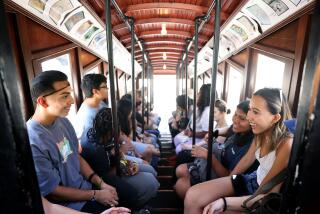DOWNTOWN : Talk Show Invites Youths to âGet Realâ
Many of them come from families that follow traditional Asian customs of behavior--reserved, obedient and soft-spoken in public.
But Asian teens born or raised in America are trying to break out of that mold and find their own voice. Some are doing it through a year-old TV talk show, âGet Real.â
The KSCI-TV Channel 18 series, which started airing monthly in April, 1993, gives high school- and college-age youths a forum to speak out on issues ranging from racial conflicts to media images of Asian Americans.
One regular panelist said she wanted to appear on âGet Realâ to increase the visibility of Asians in the media.
âI think itâs really important for us to see us in the media,â said Hae Jin Lee, 18, of Westlake. âThat shows that weâre involved in the community. Weâre not silent.â
Indeed, the need for Asians to be heard motivated âGet Realâ co-producer Martie Quan to pitch the idea of an Oprah Winfrey-like, English-speaking talk show to KSCI-TV management. The station is known more for its multilingual programs that have attracted viewers from such Asian communities as Chinatown, Little Tokyo and Koreatown.
At the beginning of each show, Amy Hill, an actress of Japanese-Finnish descent, steps into the schoolyard set where teen panelists sit on bleachers. She introduces the topic and acts as a moderator throughout the program.
During a recent taping at a KSCI-TV studio near West Los Angeles, about 15 panelists discussed three topics: racial tension between African Americans and Asian Americans, media images and gender issues.
But it was the first one that ignited the most comments, especially in response to what one African American college student said about Asians.
Ellen Lee Sandor of Torrance, a guest on the show, told the group that she often has trouble communicating with Asians because theyâre not used to her assertive nature. She also challenged them to move away from the stereotype that all blacks come from South-Central or the âghetto.â
Most of the Asian panelists responded by saying that they feel intimidated by aggressive or assertive behavior and are fearful of African Americans.
âI want to be polite. I want to hear you out,â said Hae Jin Lee, a Korean-born American who uses the name âJeanâ on the show. âI feel like you donât want to give me the time.â
Said Conrad Asuncion, 18, a Filipino American from Culver City, âIf Iâm walking down the hall and 10 black people are coming toward me, Iâd be really scared âcause even though I am dark-skinned, I have slanted eyes.â
â(Blacks) make fun of me because I have slanted eyes.â
In the end, no solutions were offered. But Hill did close the segment by encouraging panelists and viewers to build âsome bridges between our races. What we need to do is have more serious discussions among ourselves . . . to clear up some misconceptions.â
Although producers have no way of tracking the showâs viewership, some Asian health and community groups around Downtown have found previous episodes useful as educational materials.
âItâs a very good tool for reaching out to our young people,â said Leo Pandac, a counselor at Pacific Asian Alcohol Program.
Pandac agreed to appear with other teens on a âGet Realâ program taped in March about alcohol abuse. He has since replayed that episode to about 40 youths and adults, and plans to show it to second-generation Cambodian teen-agers in Echo Park and Westlake.
Another program on Asian teen pregnancy solicited expert opinion from Lisa Hasegawa, coordinator of a state-funded, Chinatown-based program called Education Now and Babies Later. Hasegawa has since shown that segment to 100 junior high-age Asian teens.
â(They were) surprised that there is a show with all Asian teens,â she said.
The program airs on the second Tuesday of each month at 4:30 p.m. More than 100 youths have appeared on the program.
More to Read
The complete guide to home viewing
Get Screen Gab for everything about the TV shows and streaming movies everyoneâs talking about.
You may occasionally receive promotional content from the Los Angeles Times.






